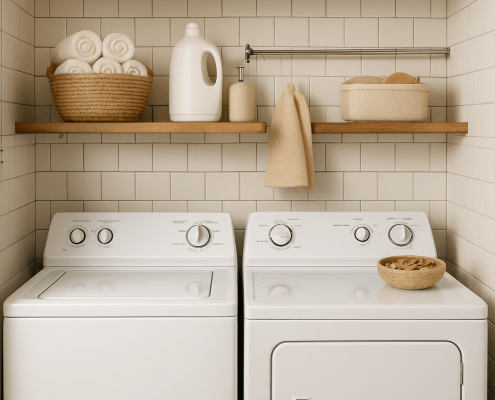How to replace the clutch on a Whirlpool washing machine
Steven E / Thursday May 15, 2025
Replacing the clutch W10754448 on a Whirlpool, KitchenAid, or Maytag washer is a straightforward do-it-yourself repair that can save you money compared to hiring an appliance repair technician. We’ll walk through the process, providing all the information and tips you need to successfully repair your washer yourself.
The information in this article may not apply to your specific appliance model. We recommend consulting your manufacturer’s documentation or contact us with any questions.
What is the clutch?
The clutch is a key component in the drive system of a direct drive washing machine. It is mounted at the bottom of the gear case and uses an electromagnet operated by the washer’s control board. By energizing and de-energizing the electromagnet, the clutch engages and disengages to switch the washer from the wash/agitate cycle to the spin cycle.
If your washer is not agitating or spinning properly, the problem may be a worn-out clutch. Testing the clutch with a multimeter can confirm if resistance is out of spec. Replacing the clutch is an inexpensive fix that can be done in under an hour with some basic tools.
Safety precautions
Safety should always be a priority when working on any appliance. Here are a few practical tips to help you stay safe:
- Turn off the power to the appliance by unplugging it or switching off the circuit breaker before starting any maintenance or repairs. This protects you from the risk of electric shock.
- Wear insulated gloves to shield your hands from sharp edges, pinching hazards, or debris.
- Work at a steady pace and take your time to avoid accidents or injuries.
- Make sure your workspace is well-lit so you can clearly see and access the parts you’re working on.
- Keep the area clear of clutter, and ensure children and pets stay out of the workspace.
- Never handle internal parts with wet hands. Check that both your hands and the work area are completely dry.
- Refer to your appliance’s user manual for any specific instructions or safety guidelines related to the part or repair.
- Handle parts gently to avoid damage to the appliance or potential injuries from applying too much force.
- Use safety glasses when dealing with chemicals, dust, or large debris to protect your eyes from harm.
- If the appliance was recently used, give it enough time to cool down before working on any heated components.
- Take photos or notes of wiring connections and terminals before disconnecting anything to make reassembly easier.
- Avoid touching exposed wires or terminals. If you must handle wires, use non-conductive tools or wear insulated gloves to minimize the risk of electrical shock.
Tools and parts required
Gather the following tools and new parts before starting:
- Socket wrench with extension – A ratcheting socket wrench allows access in the tight space. Extensions help reach mounting bolts.
- 10mm and 7mm socket heads – For removing the various mounting bolts.
- Plastic mallet – To tap the rotor bolt loose.
- Needle nose pliers – For releasing wiring harness clips.
- Replacement clutch (W10754448) – The new clutch will come with a mounting bolt. Confirm the part number for your washer model.
Removing the old clutch
With the proper safety precautions taken, you’re ready to tilt the washer and dive into the repair. Follow these steps to remove the faulty clutch:
- Tilt the washer onto its front – Place a sturdy box or blocks under the front feet for support. Tilt slowly until resting safely on the box.
- Remove the lower insulation pad – Pull up the pad surrounding the base of the washer. Set it aside without ripping or creasing it.
- Remove the rotor bolt – Use a socket wrench with an extension to access the bolt in the center of the rotor. Turn counterclockwise to loosen.
- Tap rotor loose – Give the end of the bolt a few firm hits with a plastic mallet to break the rotor free from the shaft. Avoid metal hammers.
- Lift off the rotor – Remove the bolt the rest of the way by hand. Carefully lift off the rotor, minding its strong magnets.
- Disconnect wiring plugs – Release the tabs on the two wiring plugs and pull them to disconnect them from the control board.
- Remove mounting bolts – Use the 10mm socket to remove the upper mounting bolt and the 7mm socket for the two lower stator bolts.
- Release wiring harness – Unclip the wiring harness from its plastic retainers. Allow it to hang freely.
- Lift off stator and clutch – With all bolts and clips free, carefully lift the stator and clutch up and off of the gear shaft.
- Inspect clutch – Closely inspect the clutch for any cracks, chips, or abnormal wear. Test continuity with a multimeter if possible.
Installing the new clutch
Once the old clutch is removed, it’s time to install the new replacement clutch:
- Position new clutch – Orient the new clutch on the stator with its wiring harness through the center hole.
- Insert harness in retainers – Route the wiring harness through the plastic retainers on the stator.
- Connect wiring plug – Insert the wiring plug into its socket on the control board. Ensure it clicks fully into place.
- Install stator and clutch – Carefully lower the assembly onto the gear shaft. Align the mounting holes.
- Replace lower bolts – Thread in the two 7mm stator mounting bolts and tighten securely with the socket wrench.
- Install upper bolt – Tighten down the 10mm upper mounting bolt using the socket wrench.
- Reconnect plugs – Plug the two wiring harness connectors back into the control board. Listen for a click.
- Replace rotor – Align the rotor on the splines and use the supplied bolt to secure it. Tighten firmly.
- Tap bolt tight – Give the end of the rotor bolt a few taps with the plastic mallet to fully seat it.
- Reinstall insulation pad – Place the insulation pad back around the base of the washer.
Finishing the repair
Once the new clutch is installed, button things up and test the washer:
- Turn the water supply lines back on and check for leaks.
- Carefully tilt the washer back into an upright position.
- Plug in the washer power cord.
- Initiate a test cycle and verify proper operation through all stages.
- Watch and listen for any abnormal noises or issues starting up.
- Allow the test cycle to complete fully to ensure no leaks occur.
Some minor leaking may happen at first as the new seal seats into place. However, any persistent leaks indicate improper installation. The agitation and spin should now be restored with the fresh clutch.
More information
If you need any replacement parts for your appliances, you can enter your model number at AppliancePartsPros.com to locate and order them quickly. Most orders arrive in just two business days, and we have tons of great information in our repair help section and YouTube videos to help you troubleshoot.
Stay connected with the latest DIY tips, tutorial videos, and repair guides by following us on Facebook, Instagram, and Twitter. We love hearing about your repair stories and successes. If you need more help or want personalized guidance, feel free to reach out. We’re ready to help you take on your next project with confidence!
With nearly a decade of experience in providing top-notch customer service regarding appliance parts and repair, Steven enjoys sharing practical advice, troubleshooting tips, and interesting information to help readers stay informed.





